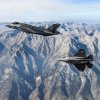Install the app
How to install the app on iOS
Follow along with the video below to see how to install our site as a web app on your home screen.
Note: This feature may not be available in some browsers.
You are using an out of date browser. It may not display this or other websites correctly.
You should upgrade or use an alternative browser.
You should upgrade or use an alternative browser.
F-35 Lightning II
- Viestiketjun aloittaja Hejsan
- Aloitus PVM

Lawmakers pressure Lockheed to pay back Pentagon for F-35 parts problems
The Pentagon wants financial compensation for F-35 parts that are not ready to install upon delivery.
Panssari Salama
Respected Leader
Tää oli mielenkiintoinen:Pitkä juttu.
Lengthy F-35 Upgrade List To Transform Strike Fighter’s Future Role | Aviation Week Network
Leaps in computing power, sensors and weapons will benefit the F-35 in the next eight years—if Lockheed can keep modernization on track.aviationweek.com
Avaa todella mielenkiintoisia näkymiä ELSO rintamalle, kun saatu data on monipuolisesti eri taistelujärjestelmien käytössä.
- The F-35’s role has already evolved from standard counterair and strike missions. The Army and Navy now use the F-35’s sensor data remotely to guide their interceptors to knock down incoming missiles. The Air Force’s decentralized command-and-control system relies on the F-35’s processing power, sensor data and communication hooks to orchestrate a wider attack in all domains. F-35 pilots still train to perform traditional fighter missions, but the role the aircraft plays defies the vocabulary of the Air Force’s designation system.
Teräsvilla
Eversti
Mitä tuo Armyn ja Navyn kuvaus käytännössä tarkoittaa, eli mitä on interceptors?Tää oli mielenkiintoinen:
Avaa todella mielenkiintoisia näkymiä ELSO rintamalle, kun saatu data on monipuolisesti eri taistelujärjestelmien käytössä.
Panssari Salama
Respected Leader
Tulkitsen että ilmataisteluhävittäjät kuten F-15 ja F-16Mitä tuo Armyn ja Navyn kuvaus käytännössä tarkoittaa, eli mitä on interceptors?
Muoks wiki kuvaa näin
An interceptor aircraft, or simply interceptor, is a type of fighter aircraft designed specifically for the defensive interception role against an attacking enemy aircraft, particularly bombers and reconnaissance aircraft. There are two general classes of interceptor: relatively lightweight aircraft built for high performance over short range, and heavier aircraft designed to fly at night or in adverse weather and operate over longer ranges.
Eli hävittäjät(yypit), joita käytetään vastustajan hävittäjien ja pommittajien tuhoamiseen ennen kuin ne ehtivät omille maalialueilleen.
Teräsvilla
Eversti
Kummallakaan ei taida olla noita koneita.Tulkitsen että ilmataisteluhävittäjät kuten F-15 ja F-16
Panssari Salama
Respected Leader
Ihan totta, Armeijalla ainakin aiemmin oli kielto ylläpitää kiinteäsiipisiä ilmataistelukoneita, helikopterit ja maataistelukoneet o(li)vat sallittuja. Ja Laivastolla tosiaan Huurnetteja. Ilmavoimat toki sitten oma lukunsa.Kummallakaan ei taida olla noita koneita.
Teräsvilla
Eversti
Mietin kans että jos Suomelle ollaan hankkimassa salamoita ykköslinjan hävittäjiksi, niin siinä ei ainakaan muita taistelukoneita enää oo tukemassa. Tai no Hawkithan varmaan ampuu sakaramiinoja =DIhan totta, Armeijalla ainakin aiemmin oli kielto ylläpitää kiinteäsiipisiä ilmataistelukoneita, helikopterit ja maataistelukoneet o(li)vat sallittuja. Ja Laivastolla tosiaan Huurnetteja.
Mielenkiintoinen yksityiskohta. Olis kiva kuulla jos foorumilta löytyy käsitystä mitä tuo voi tarkoitaa. Ja sitten keskustelu kuumaksi mitä se tarkoittaa meidän kannalta.
Gyllis1
Respected Leader
Tuo viittaa CEC-kykyyn.Mietin kans että jos Suomelle ollaan hankkimassa salamoita ykköslinjan hävittäjiksi, niin siinä ei ainakaan muita taistelukoneita enää oo tukemassa. Tai no Hawkithan varmaan ampuu sakaramiinoja =D
Mielenkiintoinen yksityiskohta. Olis kiva kuulla jos foorumilta löytyy käsitystä mitä tuo voi tarkoitaa. Ja sitten keskustelu kuumaksi mitä se tarkoittaa meidän kannalta.
Eli käytännössä esimerkiksi laivaston alus tai armeijan ilmatorjuntayksikkö ampuu torjuntaohjuksen F-35:lta tulevan maalitiedon perusteella.
Gyllis1
Respected Leader
Eli tässä kontekstissa termiä interceptor ei käytetä hävittäjistä vaan:Tuo viittaa CEC-kykyyn.
Eli käytännössä esimerkiksi laivaston alus tai armeijan ilmatorjuntayksikkö ampuu torjuntaohjuksen F-35:lta tulevan maalitiedon perusteella.
The Standard Missile-6 (SM-6) is an endo-atmospheric interceptor, which uses a blast-fragmentation warhead to engage cruise missiles, aircraft, and ballistic missiles in the terminal phase. as its kill vehicle. The U.S. Navy is also upgrading the SM-6 to perform strike missions

How the F-35 could be a game-changer for Singapore
What would change for Singapore if it purchases the stealthy fighter jet? And where will it train the pilots?
CEC tarkoittaa sensoriverkkoa, jossa eri lavettien sensorit on yhdistetty yhtenäiseksi tilannekuvaksi ja jossa lavetit ohjaavat toistensa sensoreita. Maalinosoitustieto voidaan saada myös pelkästään datalinkin välityksellä, kunhan sen tiedonsiirtokapasiteetti riittää käyteettävän aseen ja kohteena olevan maalin yhdistelmään.
Goldfein is the sixth Chief to preside over USAF’s F-35 program. The service asked for just 48 of the jets per year, but Congress added a dozen more airplanes in each of the last few budget cycles. At the current rate, USAF’s program of record—1,763 airplanes—won’t be fulfilled until the 2040s. Given that the Air Force is already embarked on the Next-Generation Air Dominance (NGAD) project, will the service throttle back on the F-35?
“The program of record hasn’t changed,” Goldfein said. “Signaling any reduction on the program of record right now” would be a mistake, he argued, especially when countries “on NATO’s Eastern flank” and partners in the Pacific are signing up to buy the F-35. “We need every country that’s even considering purchasing the F-35 to get into fifth gen,” he insisted. “We need more teammates in the game. … The last thing I want to do as an international air chief is signal any weakening.”

The Goldfein Years | Air & Space Forces Magazine
Chief 21’s Legacy is His Vision for the Future: A Highly Connected Joint Force.
Siis torjuntahävittäjäTulkitsen että ilmataisteluhävittäjät kuten F-15 ja F-16
Muoks wiki kuvaa näin
Eli hävittäjät(yypit), joita käytetään vastustajan hävittäjien ja pommittajien tuhoamiseen ennen kuin ne ehtivät omille maalialueilleen.

F-35s Nest In Big New Alaskan Facility Marking Strategic Shift For Critical Region
Eielson Air Force Base's huge new F-35 wing will rapidly become one of the U.S. Air Force’s most important units.
Torjuntahävittäjä.Tulkitsen että ilmataisteluhävittäjät kuten F-15 ja F-16
Muoks wiki kuvaa näin
Eli hävittäjät(yypit), joita käytetään vastustajan hävittäjien ja pommittajien tuhoamiseen ennen kuin ne ehtivät omille maalialueilleen.
Panssari Salama
Respected Leader
Siis torjuntahävittäjä
Näin siinä käy kun lukee melkein pelkästään englanninkielisiä artikkeleita ja kirjoja. Suomenkieli unohtuu.Torjuntahävittäjä.
Kohta käy kun Sämpylle siinä vanhassa Uuno Turhapurossa, jossa sen hahmo aloitti ruotsin opiskelun kirjekurssina, ei oppinut, mutta unohti kyllä suomenkielen ... Mikä se hahmo oli. Tossavainen?
14 years ago it was believed that F-35’s RCS was slightly inferior to that of F-22. Real world RCS testing revealed F-35 exceeding its RCS requirement. Since then, pilots and people having access to the program such as former commander of Air Combat Command, Gen. Hostage, points to the notion that F-35 is actually stealthier than F-22. So in worst case, let’s consider F-35’s RCS similar to the F-22 (i.e. “metal marble” = 0.0001 m^2)
91N6E is S-400’s primary Search radar. Based on public data, it can detect a normal fighter aircraft (RCS: 4 m^2) from 390 km maximum. Using radar equation, for F-35 (0.0001 m^2 RCS) this corresponds to <30 km.
Worth noting that this is not the range a S-400 can engage F-35. For that, the Fire-control radar 92N6E Gravestone must be able to track it. The only reliable data about Gravestone (that I know of) is from Aviation Week.
Almaz-Antey says the S-400’s 92N6E “Gravestone” fire-control radar can detect a 4-m2 radar-cross-section target at 250 km.
Source: Measuring Stealth Technology's Performance. You can read full article here: Stealth - Part 1 - Measuring Stealth Technology's Performance
That figure corresponds to 17.6 km against a 0.0001 m^2 target.
None of these figures include on or off-board EW/jamming, something the F-35 is very capable of and having such low RCS makes jamming much more effective.
There might be some Low Frequency radars that could potentially detect F-35 at slightly longer range and provide Early Warning but they’re incapable of providing any kind of targeting information, something the question gives emphasis on. Not to mention that they’re much more prone to jamming (by other platforms) due to lower operational bandwidth.
This is the closest you get with the public information.
Edit: As pointed out by Chuck Hunter, it’s important to remember that these detection ranges are not accurate for LO aircraft like F-35. Because in reality, there will be enormous difference in background noise between a 4 m^2 class target vs. a marble or golf-ball class target – something the radar equation used for calculation doesn’t account.
So in real world, the detection range for F-35 will be even lower than the corresponding figures. This also explains why most radars are incapable of detecting/tracking VLO aircraft like F-22 or F-35 in real world even from close ranges.
These figures only provide a context into the subject and shows how big of a tactical advantage F-35 has against S-400 compared to non-stealthy platforms.
91N6E is S-400’s primary Search radar. Based on public data, it can detect a normal fighter aircraft (RCS: 4 m^2) from 390 km maximum. Using radar equation, for F-35 (0.0001 m^2 RCS) this corresponds to <30 km.
Worth noting that this is not the range a S-400 can engage F-35. For that, the Fire-control radar 92N6E Gravestone must be able to track it. The only reliable data about Gravestone (that I know of) is from Aviation Week.
Almaz-Antey says the S-400’s 92N6E “Gravestone” fire-control radar can detect a 4-m2 radar-cross-section target at 250 km.
Source: Measuring Stealth Technology's Performance. You can read full article here: Stealth - Part 1 - Measuring Stealth Technology's Performance
That figure corresponds to 17.6 km against a 0.0001 m^2 target.
None of these figures include on or off-board EW/jamming, something the F-35 is very capable of and having such low RCS makes jamming much more effective.
There might be some Low Frequency radars that could potentially detect F-35 at slightly longer range and provide Early Warning but they’re incapable of providing any kind of targeting information, something the question gives emphasis on. Not to mention that they’re much more prone to jamming (by other platforms) due to lower operational bandwidth.
This is the closest you get with the public information.
Edit: As pointed out by Chuck Hunter, it’s important to remember that these detection ranges are not accurate for LO aircraft like F-35. Because in reality, there will be enormous difference in background noise between a 4 m^2 class target vs. a marble or golf-ball class target – something the radar equation used for calculation doesn’t account.
So in real world, the detection range for F-35 will be even lower than the corresponding figures. This also explains why most radars are incapable of detecting/tracking VLO aircraft like F-22 or F-35 in real world even from close ranges.
These figures only provide a context into the subject and shows how big of a tactical advantage F-35 has against S-400 compared to non-stealthy platforms.

